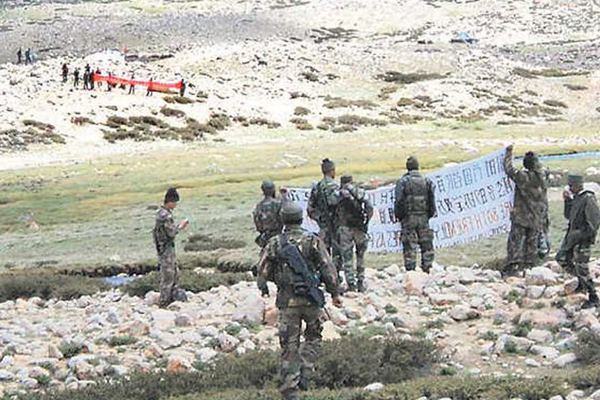India and China, on 13 September, carried out verification to confirm withdrawal of troops from Patrolling Point (PP) 15 in the Gogra-Hot Springs area of Eastern Ladakh, marking the completion of the disengagement here.
On 8 September, the two countries announced that their armies had begun to disengage from PP15 in Gogra-Hot Springs, marking a step forward to end the standoff ongoing since May 2020. Ministry of External Affairs (MEA) had said that the two countries will take up remaining issues along the LAC once the ongoing disengagement at PP15 is complete.
Beijing had welcomed the disengagement at PP15 as “a positive development”, but reiterated that it would not accept India’s demand for restoration of status quo ante prior to the standoff saying that “the status quo of April 2020…was created by India’s illegal crossing of the LAC”.
Disengagement at Pp15
In the Chang Chenmo sector, where the LAC and the 1959 Claim Line coincide, there were no areas of differing perception as such. This sector is the gateway to the three southern approaches that lead to Aksai Chin. One approach to the east leads to Lanak La, through which the Tibet-Xinjiang highway passes. Two approaches are to the north via the Changlung Nala – PP17A and Kugrang River – PP15, which lead to the upper reaches of the Galwan River.
The Indo-Tibetan Border Police (ITBP) has its main post at Karam Singh Hill at the junction of Kugrang and Chang Chenmo rivers and an outpost at Gogra. PPs 15, 16 and 17A were patrolled but not physically held. Alarmed at the rapid development of roads by India to PP15, PP17A and towards Kongka La, the People’s Liberation Army (PLA) intruded 3 to 4 km across the LAC between PPs 15 and 16 and PPs 17A and 17.
These intrusions were contested by Indian forces and a stalemate ensued. During negotiations, the Chinese gave a new version of the 1959 Claim Line up to their intrusions, running along the middle as opposed to the well-established LAC, which runs along the crest of the ridge to the north of the Kugrang River.
Disengagement with respect to the Changlung Nala intrusion took place between 4-5 August 2021, after the 12th round of military talks on 31 July. However, China refused to budge on the intrusion between PPs 15 and 16. It insisted on a buffer zone of 30-35 km along the entire length of the Kugrang River up to Karam Singh Hill. This proposal was also mooted during Wang Yi’s visit to Delhi earlier in March 2022.
PLA enjoyed the terrain advantage in both the intrusion areas in this sector. Due to terrain configuration, the Chanchenmo sector, dependent on a tenuous 100 km long road from Lukung which can be cut off at several places, is untenable in war unless disproportionate forces are deployed.
Depsang and Demchok Next
India maintains that friction points at Demchok and Depsang remain, China has refused to accept them as legacy issues pre-dating the 2020 standoff. Demchok is one of the two mutually agreed disputed areas in Eastern Ladakh, while Depsang is one of the eight friction points in the area. In Demchok, while there are varying claims in the Charding La area, China has set up tents on this side of Charding nala.
Since the beginning of the standoff there has been heavy Chinese presence in the Depsang plains, at a crucial area called the Bulge and PLA troops have also been blocking Indian Army patrols from reaching the PPs 10, 11, 11A, 12 and 13, located on the Limit of Patrolling which lies much before the LAC.
The Chinese build-up threatens Indian positions at Burtse and Raki Nala well inside Indian territory and further Daulat Beg Oldie (DBO) by bringing Chinese troops closer to the 255 km long crucial Darbuk-Skyok-DBO road. Depsang is also close to the Karakoram pass overlooking the very strategic Saltoro ridge and Siachen glacier.
Negotiations for disengagement in Depsang Plains and Demchok will be arduous and prolonged.
Comments
Considering that it took nine years to restore the status quo post the Sumdorong Chu confrontation of 1986-87 which began during Rajiv Gandhi’s tenure and ended under the Narasimha Rao government, it is clear that border negotiations with China are a long and arduous process.
The withdrawal of soldiers and dismantling of temporary infrastructure took place less than two months after the two sides took part in the 16th round of high-level military talks. India’s insistence on a sustained dialogue to thrash out issues and settle differences has borne fruit.
The India-China standoff has been continuing since May 2020; its impact on bilateral ties cannot be overestimated. The situation reached a flashpoint in June 2020 when rival troops were involved in a bloody clash in the Galwan valley. Since then, an uneasy calm has prevailed in Ladakh, with India trying to keep pace with China in terms of troop build-up, round-the-clock surveillance and raising of infrastructure.
Even as the PP-15 breakthrough is welcome, the Indian defence forces cannot rule out the possibility of another misadventure by the People’s Liberation Army. Indian troops have to remain on their toes to ensure that peace and tranquillity are maintained on a long-term basis along the Line of Actual Control (LAC).
Now that PP-15 has been successfully dealt with, the next logical step should be to resolve the stalemate in Demchok and Depsang regions. Doing the needful will prepare the ground for talks on the long-festering boundary dispute. It is imperative to clearly delineate and demarcate the nearly 3,500-km LAC by mutual consent and establish it as permanent international border so as to preclude future imbroglios. New Delhi has been asserting that normalcy in bilateral relations is not possible unless sincere efforts are made to ensure a friction-free border.


















